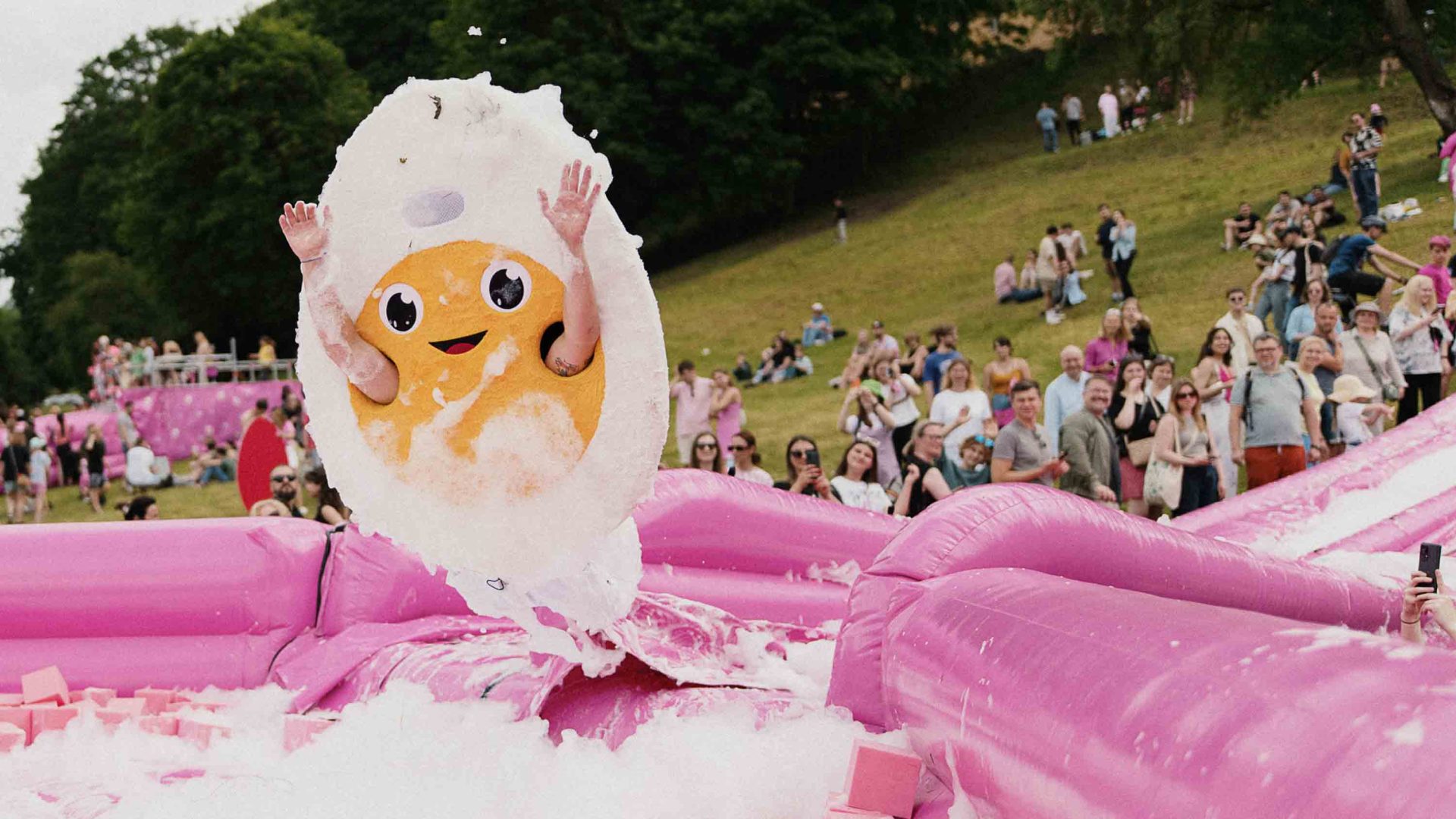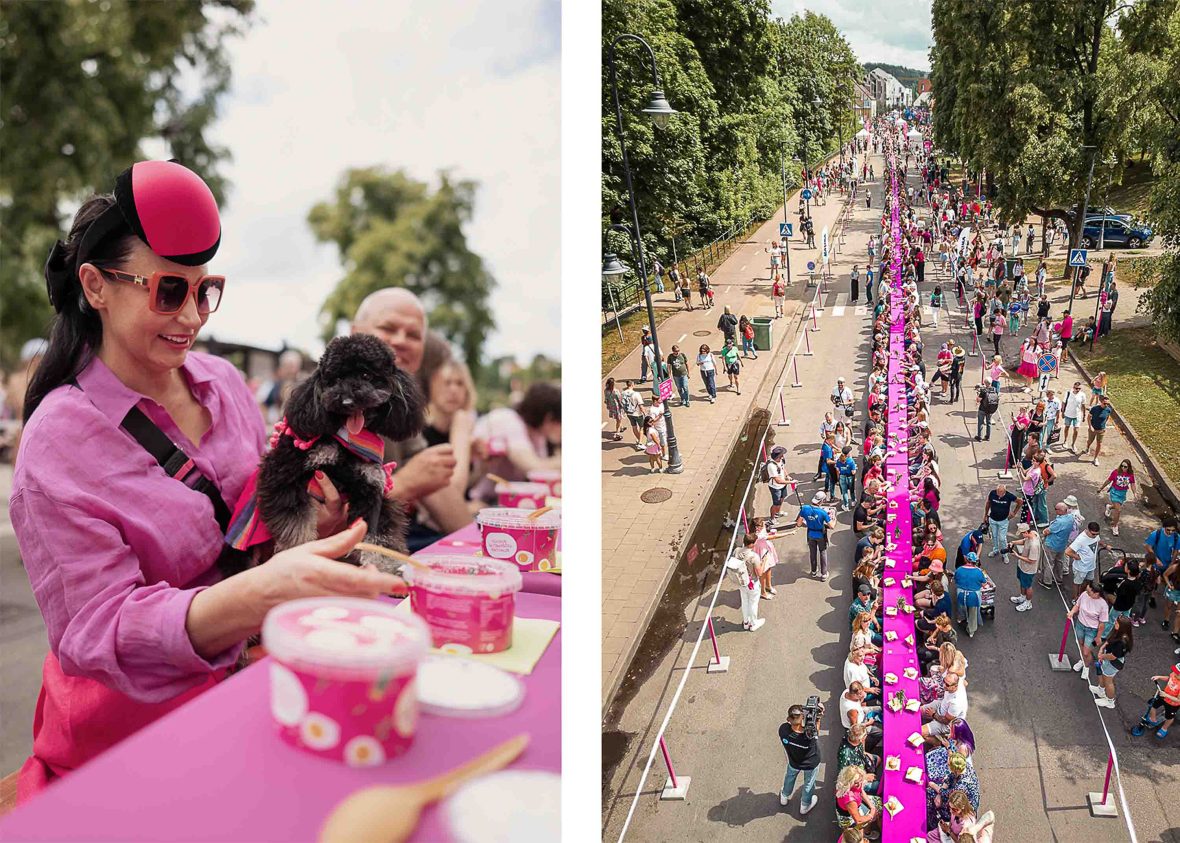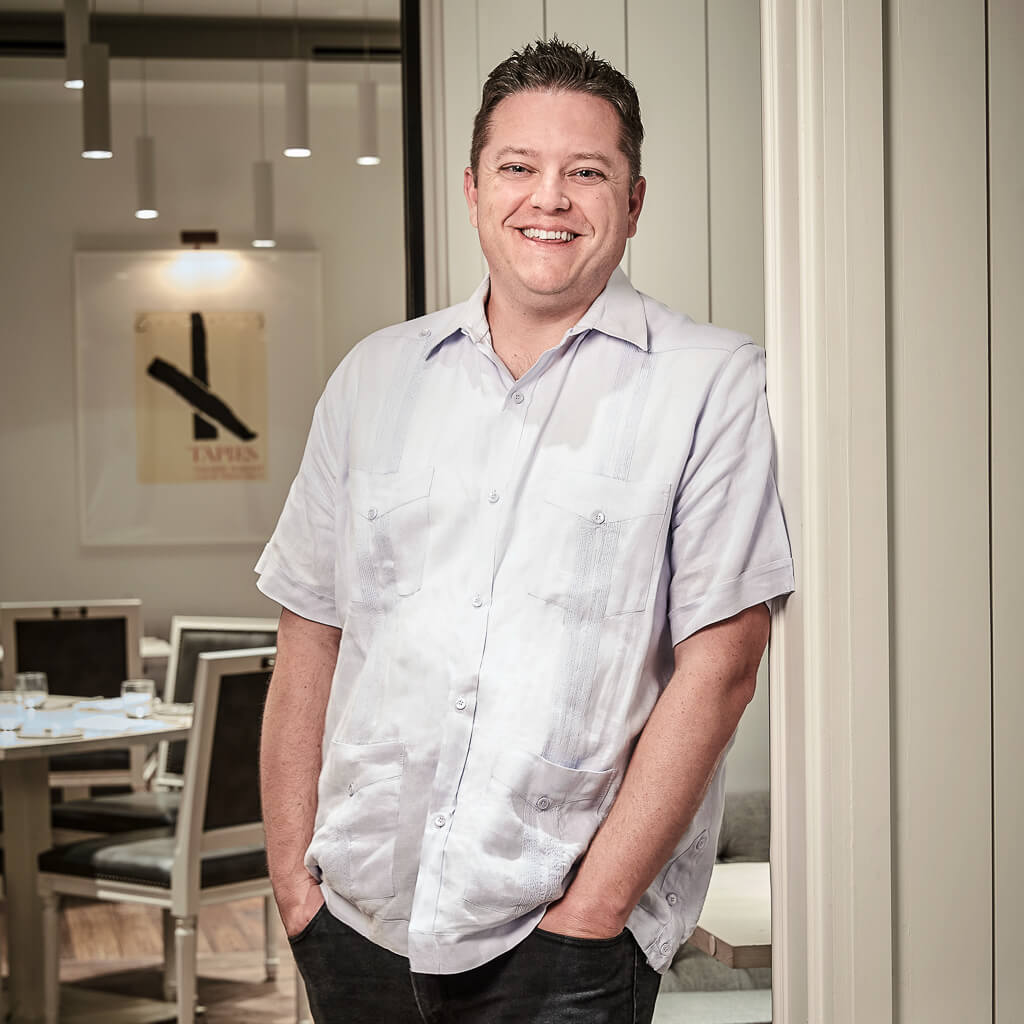
Who knew a Baltic beetroot-based šaltibarščiai soup would become the emblem of a lost-and-found food heritage? Travel and food writer Toyo Odetunde finds herself in a surprisingly pink Barbie world in Lithuania.


Who knew a Baltic beetroot-based šaltibarščiai soup would become the emblem of a lost-and-found food heritage? Travel and food writer Toyo Odetunde finds herself in a surprisingly pink Barbie world in Lithuania.
Stood within the open pastoral surrounds of Vilnius’s Kūdrų Park, I watch as two sturdy men slide on their bellies down a gigantic 50-meter long inflatable Barbie-pink slide. Their bodies quickly become lathered in foam as they hurtle down the slide’s parallel lanes, before crashing into a giant pool of pink foam squares at the bottom.
A cameraman capturing their ungraceful toppling laughs heartily as he congratulates his fellow countrymen on completing this valiant act of patriotism. As the crowd’s roar crescendos, I raise my eyebrows in part-amusement, part-disbelief, and catch the gleeful smile of a woman standing directly opposite me on the other side of the slide—which is perched against Bastion Hill for a natural incline. Her own eyebrows are dyed pink.
The inflatable fuschia pool is a playful representation of a bowl of šaltibarščiai, the creamy, bright pink cold soup of cucumber, kefir or buttermilk, pickled beetroot and dill. A centuries-old staple in Lithuanian households, the soup has become synonymous with Lithuanian identity, and is now celebrated with its very own festival in Vilnius: Vilnius Pink Soup Fest.
Only in its second year, the festival sees the capital transformed into a collage of pinks, with locals and visitors discovering a varied programme of events designed to honor the dish, but also to promote cultural heritage.

“It was introduced last year as part of the celebrations for Vilnius’ 100-year anniversary,” Eglė Mačiulytė, from development agency Go Vilnius tells me. “We felt that the city should commemorate the most iconic Lithuanian dish for the occasion. It was so well-received that we decided to run it again. We’re really happy that this tradition has started and is doing so well. We now see it as the opening of the summer season.”
The city, along with the 200 or so enterprises partnering with the festival, mean business. Just a few steps outside of my hotel it becomes clear that ‘paint the town pink’ is the motto of the day. A huge silver stage framed with pink banners in the town square is ready for an open-air concert that evening; the grand finale to close out the festivities. And, in true Barbie movie premiere style, Stiklai Street has been covered in pink carpet, turning the popular artery of Vilnius’ fairytale old town into a dreamy family photoshoot backdrop.
“Our local food culture was suppressed through the standardization that came with the occupation.”
- Rimvydas Lauzikas, historian
As I meander through the pink-clad throng, posters in display windows invite me to try pink soup-themed cocktails, coffees, cakes, donuts, as well as (of course) the plat du jour—šaltibarščiai. I don’t pass a single establishment which hasn’t embraced the festival, whether through pink flags, ribbons, streamers and bunting, an ambitiously creative pink soup-themed menu, or all of the above.
The mood is infectious. I can’t help but grin as I watch the hordes, numbering up to 40,000 across the day, spilling through the streets. Schoolchildren flit around their parents, flicking pink-streaked hair between bursts of laughter; while groups of teens race up hills showing off their long, agile strides and coordinated outfits reminiscent of 90s bands. At a small shaded table outside one café, an elderly woman slowly pushes a spoon into the hood of a pram—and as I get closer, I see a delighted baby kicking out his bare feet and babbling as a slow trickle of pink soup dribbles down his chin. Šaltibarščiai for all.
The timing of the festival also helps to attract this diverse crowd. Taking place on an early summer weekend during term time, families have not yet left the city for vacation. It’s also helped by the balmy weather, central location, free entry, and—let’s face it—the universal appeal of eating.
As I cross the iron trusses of Paupys Bridge, I’m met with another unexpected spectacle. A group, each member dressed head-to-toe as a pink-soup ingredient mascot—a beetroot in a gold bikini, half a boiled egg and a carton of kefir—is dancing and rapping around a Volkswagen painted magenta and covered in pink soup motifs.
Even after walking into a pink soup rap video shoot, the surprises continue. On the other side of the bridge, starting from the newly redeveloped Paupys neighborhood, is the beginning of a seemingly endless banquet table, which runs uninterrupted for 362 meters through the center of Aukstaiciu Street. Like all passers-by, I’m offered a pastel pink raffle ticket to secure a seat at this pink soup feast. Though it’s free for all to take part, I politely decline as I’m on my way (and running late, thanks to numerous pink-hued diversions) to another pink soup lunch.
It seems fitting that this cold soup feast took place at the usual site of Tymas Market. During the 16th to 19th centuries, this area was home to ‘tymo’ (goatskin leather) craftsmen. It was demolished during the Soviet occupation and reopened in 2008, with an organic produce market every Thursday during the warmer months. The revival of this commercial hub mirrors the revival of Lithuanian gastronomic and national identity that the pink soup festival captures.
“Our local food culture was suppressed through the standardization that came with the occupation,” historian Rimvydas Lauzikas tells me, explaining an important legacy of the Soviet occupation of Lithuania. “All eateries had to follow state-imposed menu requirements, with a new national cuisine also being defined by the reducing number of ingredients that were readily available, such as potato.”
Many of the Soviet-approved potato-based dishes which dominated Lithuanian cookery during this time are still loved today, such as cepelinai, potato dumplings of Litvak origin, but dependence on these dishes resulted in many other historical recipes dying out.
“It became difficult to make zrazai (stuffed beef steak) when beef became scarce for example,” says Lauzikas. “So people used potato instead.” A trend towards reclaiming Lithuanian culinary heritage can be seen across Vilnius’ burgeoning restaurant scene, with newer spots such as Ertilo Namas drawing from the more indulgent and experimental approach to cookery taken by Lithuanian nobility during Medieval and Renaissance periods.

Pink soup is one of the most well-known dishes from pre-occupation memory, which explains its appeal as an emblem for a festival fostering national pride. But the pink soup festival is not only significant in its connection to food heritage: It also revives the very concept of using festivals to promote cultural character.
Occupation saw the repackaging of local folk and religious festivals to align with Soviet ideology. For example, Užgavėnės—a pre-Lenten festival akin to Shrove Tuesday—became the secular Ushering-out-of-Winter Festival. Today’s pink soup festival is also a renewed opportunity to celebrate being Lithuanian and share that with visitors, particularly as Vilnius becomes an increasingly popular city break destination.
Every family has their own little adaptation. Karina’s secret is fermented rather than regular cucumber, for an extra dash of sourness. But the core dish remains a unifying constant for Lithuanians.
“The soup is something we Lithuanians are really proud of,” says Karina Latakaitė, a manager at food court Paupio Turgus. After half a day criss-crossing the city, I’m ready to eat. I’ve arrived at Burna House, set inside the food court, which serves traditional Lithuanian fare. Like most of the city’s restaurants, stalls and food trucks, there’s a special menu for the festival. Karina, donning a salmon-pink two-piece with hair to match (“I dyed it for today!” she laughs), presents me with my first ever bowl of šaltibarščiai.
The soup is many things at once: Refreshing and cooling from the cucumber, herbaceous and lively with dill, savory with chive and spring onion, with a tart pinch from the fermented dairy and slight earthy sweetness from the beetroot. Each flavour demands your attention. I’m indifferent to the sliced hard-boiled egg on top, but partial to the skewers of salted crispy roasted potatoes balanced across the bowl.
It’s a good day for my gut, as the other pink soup special I try is a beetroot-flavored gira, a low-to no-alcohol drink of fermented dark rye bread, a Lithuanian staple, and ancient yeast dating nearly a millennia. Fruity, healthful and gently effervescent, it reminds me of flavored kombucha.
By the time I’m halfway through my bowl of pink soup, Burna House is full. “We’re positioned at the base of the festival so we get a lot of traffic,” Karina says. “Last year, we sold out before the end of the day. It was hard to get enough ingredients—buttermilk and spring onion were sold out everywhere. But this year everyone was more prepared.” This year, Burna House served 1,100 portions of pink soup, nearly double the 600 portions sold last year. “That’s 410 liters!” Karina laughs.
“You can find variations in neighboring countries like Latvia and Poland, but ours is something we really see as Lithuanian, using locally produced ingredients,” Karina tells me when I ask her what makes pink soup so universally cherished. “Everyone cooks it at home during summer, often a few times a week as it’s so easy to prepare.”
Every family has their own little adaptation. Karina’s secret is using fermented rather than regular cucumber, for an extra dash of sourness, but the core dish remains a unifying constant for Lithuanians. “It’s been a part of my life for as long as I can remember,” she says. “Children are introduced to it as soon as possible. If you blend it a little more, it’s great for babies—my two-year-old daughter already loves it.”
While at lunch, I miss the Pink Waiters’ Marathon, the 600-meter race inspired by the Paris Coffee Run—instead of racing whiile balancing coffees and croissants, hospitality staff try to avoid spilling bowls of precious pink soup. But back in Kūdrų Park, I do catch artist Monika Dirsytė rolling across a human bridge. Without context, her performance, ‘Roots’, may appear a little odd, but the human bridge symbolizes the connection between a people and their cultural heritage.
“It encourages us here in Vilnius to think about where we came from, and where we are now,” says Eglė. Šaltibarščiai does the same thing. “One of the first written recipes for it, from the 17th century, was from Vilnius, so it’s been part of the history of this region for a very long time. As the festival continues to grow, we’ll continue to make sure that it’s about celebrating something important to our culture, as well as having fun.”
I’m sure she’s right. I think of the foam-lathered gents from earlier; they were definitely having fun.
****
Adventure.com strives to be a low-emissions travel publication. We are powered by, but editorially independent of, Intrepid Travel, the world’s largest travel B Corp, who help ensure Adventure.com maintains high standards of sustainability in our work and activities. You can visit our sustainability page or read our Contributor Impact Guidelines for more information.








Can't find what you're looking for? Try using these tags: